Athearn Trains 50-Foot Pullman Standard Double Door Boxcar
Published: 2022-04-30 - By: CNW400
Last updated on: 2022-04-01
Last updated on: 2022-04-01
visibility: Public - Headline
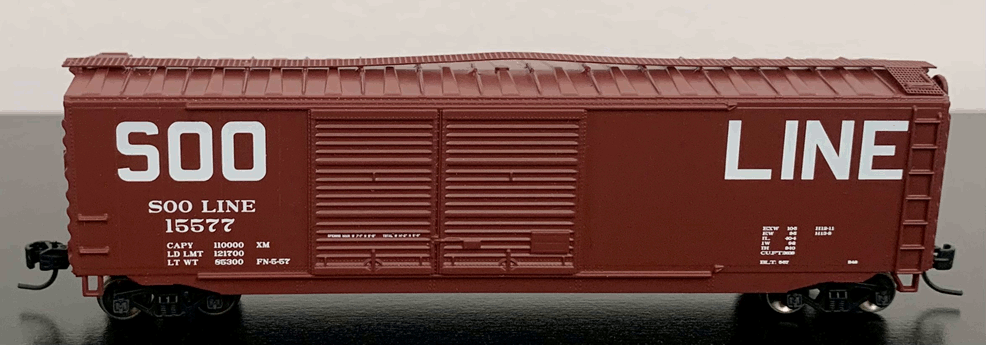
In October 2021, Athearn Trains introduced the 50-Foot Double Sliding Door Boxcar into their rolling stock family. Originally announced in July 2020, this fully assembled model is a brand-new N Scale rolling stock product for Athearn with tooling acquired from MDC/Roundhouse. The initial Athearn release includes seven different road names.
The most prevalent door sizes were either 6’, 7’ or 8’ and common styles included Youngstown or Pullman-Standard doors. The Youngstown door was used the most common with a multiple horizontal corrugation pattern. The Pullman-Standard type door featured a distinctive four corrugations per panel design with one corrugation shorter than the others. The cars were frequently painted ‘boxcar red’ and the boxcar could undergo specific changes per customer request such as the door size and style or application of a colorful paint scheme.
The Pullman designed car ends had a unique series of wide rounded corrugations – Dreadnaught ends with broad corrugations that did not narrow. Another distinguishing trait was the ‘Bow-Tie’ roof panel. The PS-1 roof panel raised sections were wider at the outside and become narrower at the roof peak creating the illusion of a bow-tie configuration. The raised roof panels and corrugations were designed to add strength.
The PS-1 began to experience considerable design changes in the early-1960s. The boxcars were fitted with shorter ladders, lower handbrakes and underwent removal of the roofwalk. Running boards were not mandatory on new equipment built after 1966 with a target date of 1974 to have running boards removed from all rolling stock. The deadline was extended to 1983 to allow removal during normal maintenance cycles. Flat roofs became more common for clearance as rolling stock grew taller.
The demand for the 40-foot boxcar slowed as the railroads gravitated towards the 50-foot boxcar and commodity-specific specialized rolling stock – by the mid-1950's the production of 50-foot boxcars outnumbered 40-foot cars. Pullman-Standard offered 50’ and 60’ versions with the PS-1 designation. The last PS-1 boxcar to be produced was in 1968.
It has been reported that 79 railroad customers purchased the PS-1 with 22 railroads owing at least 1,000 boxcars and 5 (Chicago & Northwestern, Louisville & Nashville, New York Central, Rock Island & Southern) maintaining at least 5,000 cars. The PS-1 was the definitive freight boxcar during this era; used for general merchandise, grain, and even coke & coal.
Prior to World War II, 50-foot boxcars were mainly used for automobiles, auto parts, furniture, appliances, or other specialized services. The 50-foot cars had an all-steel design with a 12 thru 16 side panel configuration (40-foot boxcars commonly had a 10-panel pattern). Large double doors were installed to accommodate the bulky oversized freight. Double door size compositions varied with combined width openings ranging from 12’-6” to 16’ with either two standard sliding doors or the plug door and sliding door combination made popular in the late 1950’s. Some boxcars were equipped with end doors to load and unload bulky cargo such as trucks and heavy machinery.
Well into the 1950’s, the most common way to transport automobiles was in the double door boxcar. Automobile boxcars were identified with a white stripe on the right-side door panel. The word ‘Automobile’ was stenciled on each side of the railcar along with the interior height, number of tie-downs and, if any, the type of racks installed. The boxcar was not the most efficient means to haul automobiles – they proved difficult to load and only held two vehicles until internal racks were designed by Evans Products. The Evans racks doubled the hauling capacity of 50-foot boxcars to four automobiles with two vehicles elevated upward towards the roof and the other two autos positioned below them. Reinforcement strips were installed along the side sills below the doors to support the extra weight. The boxcar remained the mode of automobile transport until multi-level autorack railcars started to be introduced into service during the years 1959-1960. In modern times, 16-foot-wide double door boxcars are often used for lumber, hauling plywood and other wood sheet products.
The Minneapolis, St. Paul & Sault Ste. Marie or better known as the Soo Line, can trace its beginnings back to the 1870’s. Minnesota businessmen were seeking an independent rail connection eastward to cease paying outlandish fees charged by the Chicago and Milwaukee based rail lines. They also wished to establish lines northwest of Minneapolis into the Dakota Territory to furnish hard spring wheat for the state’s grain milling industry.

SOO Line Logo
The privately financed railroad, originally named the Minneapolis, St. Paul and Atlantic, ran on its first 46 miles of track in 1884 into northern Wisconsin – connecting to Minneapolis via track leased from the Chicago, St. Paul, Minneapolis, and Omaha. By 1887, the Minneapolis, St. Paul and Atlantic reached the Port of Sault Ste. Marie on the St. Mary’s River. Sault Ste Marie, Michigan and Sault Ste. Marie, Ontario, better known as the ‘Twin Saults,’ are international ports of entry between the United States and Canada.
In 1888, the Minneapolis, St. Paul and Atlantic Railroad merged with the lines heading into the Dakota Territory and formed the Minneapolis, St. Paul & Sault Ste. Marie Railway (Soo Line – pronunciation of Sault sounds like Soo or Sue). The Canadian Pacific Railway, hoping to block the Grand Trunk Railway expansion into Canada, gained controlling interest on the newly established railroad later that year. The Soo Line continued to operate as a separate company and built new trackage to connect with Canadian Pacific lines at Portal, North Dakota and Noyes, Minnesota.
In 1909, the Soo Line took control of the Wisconsin Central Railroad with a ninety-nine-year lease of all WC properties. Headquartered in Minneapolis, this allowed direct access to Chicago and the iron ore mines in northern Wisconsin. Thus, besides hauling grain and lumber from the upper Midwest, the Soo Line was able to add passenger service and iron ore transport to its main operations.
In 1961, Canadian Pacific controlled Duluth, South Shore and Atlantic Railroad (DSS&A) and the Wisconsin Central Railway merged with the Minneapolis, St. Paul & Sault Ste. Marie Railway to officially create the Soo Line Railroad. The Canadian Pacific also obtained controlling interest of the iron ore and lumber hauling DSS&A in 1888 to further blockage the Grand Trunk’s expansion into Canada.
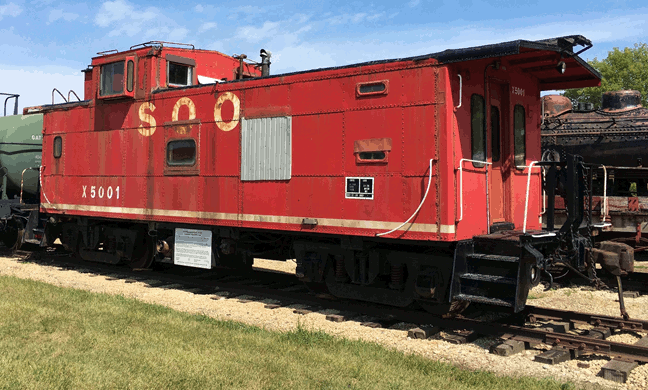
Soo Line Caboose X5001 – IRM in Union, IL (Koltz)
Like most railroads, competition from automobile ownership, the highway system and airlines contributed to the demise of the Soo Line passenger service. The Soo Line started to reduce local passenger service and vacation routes in 1959. In March 1968, the Soo Line discontinued passenger service all together.
In 1985, the Soo Line purchased the bankrupt Chicago, Milwaukee, St. Paul & Pacific Railroad (Milwaukee Road). After the merger of assets, the Soo Line sold track rights back to the Wisconsin Central – recreating the pre-1909 railroad. In 1990, Canadian Pacific gained full ownership of the Soo Line. By 1992 the Soo Line name was no longer in use and all Soo Line properties fell under the CP Rail Systems corporate umbrella.
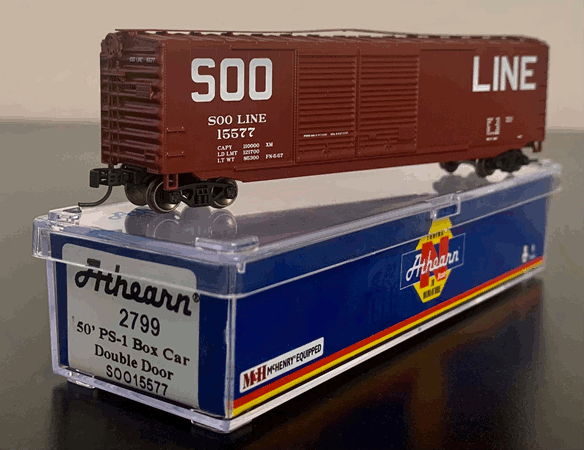
Model with box
Note: I used photographs before the repair was completed to truly represent how the model appeared “out-of-the-box".
The paint job is crisp and even along the entire injection molded plastic model. The Soo Line boxcar is painted Freight Car Red with white lettering. The Soo Line name is stenciled in prototype correct large billboard lettering, positioned near the car ends. This style was adopted by the railroad in 1953. Prior to that year, the road name was centered on Soo Line rolling stock. Lettering is extremely neat and clear, even when some magnification is needed for the smaller printing. Rivets, panel lines and door latches are sharp.
Besides the typical weight limit and boxcar dimensions, some unique stenciling for the curious includes:
The sides of the model closely resemble prototype images of Soo Line #15578. The Athearn model and the prototype each share a 12-panel (5x7) side configuration, stirrup steps, two grab irons on the "SOO” end and a full-length ladder on the "LINE” end. The Athearn model is painted and stenciled in the era correct font, color and size when compared to the real-life boxcar. The model double doors do not open, and the route and placard boards are both correctly mounted low on the right-side door. The AAR safety rules in the mid-1950's were updated to move the placard boards from up high to down low to be seen by trainmen on the ground. Lastly, the sides feature the tapered fishbelly sills Pullman-Standard began to use in the late 1950s.
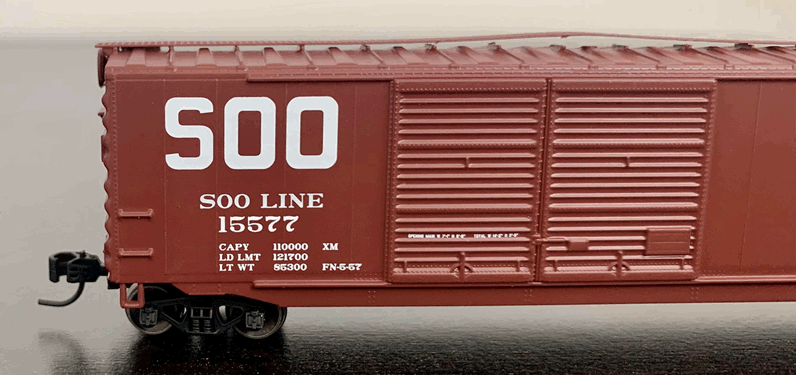
Prototypical Design – Crisp Printing
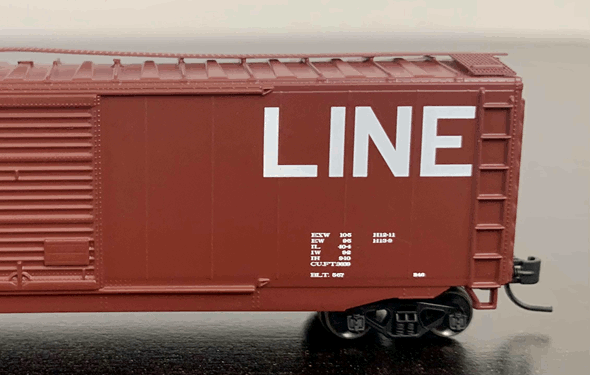
Era Correct Fishbelly Sills
Both ends feature molded full height ladders, grab irons, a high mounted placard board, and Pullman-Standard 4/5 Dreadnaught end with six indentations in the hat section. The brake end has a high mounted Universal wheel with brake rods and brake platform. Again, the lettering is neat and in proper arrangement with the road marker & road number on the top right corner of each end.

Brake Wheel detail

Pullman-Standard 4/5 Dreadnaught Ends
The metal panel roof features the Pullman-Standard proprietary ‘bow-tie’ pattern with an extended running board, lateral running boards on both ends and corner grab irons atop the full-length body ladders.
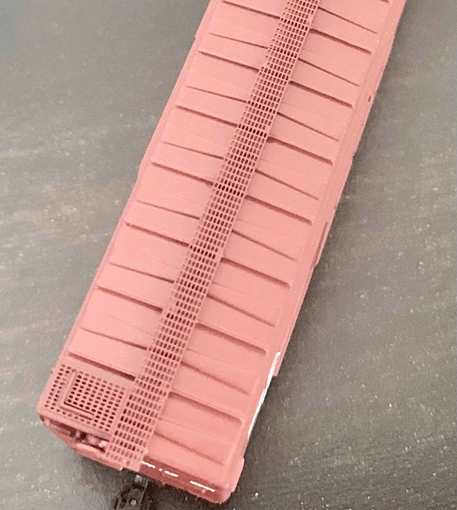
Pullman-Standard Roof Panels with See-Thru Roofwalk
The black underframe has a molded AB brake system arrangement with features such as the brake cylinder, brake reservoir, control valve and brake rod. The boxcar is fitted with screw mounted Bettendorf trucks with shiny metal wheels. Finally, the model is equipped with proper height body mounted McHenry knuckle spring couplers.

Molded AB Brake System with Silver Metal Wheels & Body-Mounted Coupler
The car is 3 7/8 inches in length and weighs about 1.1 ounces, which is perfect according to the National Model Railroad Association (NMRA) recommendations (which are 1.1 - 1.2 ounces for this size car). I found it an excellent runner while testing the car on Kato Unitrack with no issues around curves or through turnouts at slow and medium speeds.
Another solid release from Athearn Trains – even with the bowed roofwalk which was an easy fix, which we will call an anomaly. Prototypical design and printing - an excellent runner with prefect weight, metal wheels (yeah!) and body-mounted couplers. My usual complaint with manufactures using older tooling without adding the features the modern hobbyist desires – such as separately applied parts and boxcar doors that open. Overall, an exceptional representation of the Pullman-Standard Double Door for those wishing to add a few common boxcars to your layout at a reasonable cost.
To see a list of all cars in this series, CLICK HERE.
Road Names and Pricing
- Baltimore & Ohio
- Great Northern
- Gulf, Mobile & Ohio
- Illinois Central
- New York Central
- Soo Line
- Southern
Prototype History
The PS-1 was based on the 1942 American Association of Railroads (AAR) industry standard, revised with Pullman’s proprietary roof and car end designs. The omnipresent PS-1 boxcar was produced from 1947 through 1968 with most of the cars having a length of 40’ and heights of either 10’5” or 10’6”. Although the early models were riveted, most PS-1 cars featured welded construction.The most prevalent door sizes were either 6’, 7’ or 8’ and common styles included Youngstown or Pullman-Standard doors. The Youngstown door was used the most common with a multiple horizontal corrugation pattern. The Pullman-Standard type door featured a distinctive four corrugations per panel design with one corrugation shorter than the others. The cars were frequently painted ‘boxcar red’ and the boxcar could undergo specific changes per customer request such as the door size and style or application of a colorful paint scheme.
The Pullman designed car ends had a unique series of wide rounded corrugations – Dreadnaught ends with broad corrugations that did not narrow. Another distinguishing trait was the ‘Bow-Tie’ roof panel. The PS-1 roof panel raised sections were wider at the outside and become narrower at the roof peak creating the illusion of a bow-tie configuration. The raised roof panels and corrugations were designed to add strength.
The PS-1 began to experience considerable design changes in the early-1960s. The boxcars were fitted with shorter ladders, lower handbrakes and underwent removal of the roofwalk. Running boards were not mandatory on new equipment built after 1966 with a target date of 1974 to have running boards removed from all rolling stock. The deadline was extended to 1983 to allow removal during normal maintenance cycles. Flat roofs became more common for clearance as rolling stock grew taller.
The demand for the 40-foot boxcar slowed as the railroads gravitated towards the 50-foot boxcar and commodity-specific specialized rolling stock – by the mid-1950's the production of 50-foot boxcars outnumbered 40-foot cars. Pullman-Standard offered 50’ and 60’ versions with the PS-1 designation. The last PS-1 boxcar to be produced was in 1968.
It has been reported that 79 railroad customers purchased the PS-1 with 22 railroads owing at least 1,000 boxcars and 5 (Chicago & Northwestern, Louisville & Nashville, New York Central, Rock Island & Southern) maintaining at least 5,000 cars. The PS-1 was the definitive freight boxcar during this era; used for general merchandise, grain, and even coke & coal.
Prior to World War II, 50-foot boxcars were mainly used for automobiles, auto parts, furniture, appliances, or other specialized services. The 50-foot cars had an all-steel design with a 12 thru 16 side panel configuration (40-foot boxcars commonly had a 10-panel pattern). Large double doors were installed to accommodate the bulky oversized freight. Double door size compositions varied with combined width openings ranging from 12’-6” to 16’ with either two standard sliding doors or the plug door and sliding door combination made popular in the late 1950’s. Some boxcars were equipped with end doors to load and unload bulky cargo such as trucks and heavy machinery.
Well into the 1950’s, the most common way to transport automobiles was in the double door boxcar. Automobile boxcars were identified with a white stripe on the right-side door panel. The word ‘Automobile’ was stenciled on each side of the railcar along with the interior height, number of tie-downs and, if any, the type of racks installed. The boxcar was not the most efficient means to haul automobiles – they proved difficult to load and only held two vehicles until internal racks were designed by Evans Products. The Evans racks doubled the hauling capacity of 50-foot boxcars to four automobiles with two vehicles elevated upward towards the roof and the other two autos positioned below them. Reinforcement strips were installed along the side sills below the doors to support the extra weight. The boxcar remained the mode of automobile transport until multi-level autorack railcars started to be introduced into service during the years 1959-1960. In modern times, 16-foot-wide double door boxcars are often used for lumber, hauling plywood and other wood sheet products.
The Minneapolis, St. Paul & Sault Ste. Marie or better known as the Soo Line, can trace its beginnings back to the 1870’s. Minnesota businessmen were seeking an independent rail connection eastward to cease paying outlandish fees charged by the Chicago and Milwaukee based rail lines. They also wished to establish lines northwest of Minneapolis into the Dakota Territory to furnish hard spring wheat for the state’s grain milling industry.

The privately financed railroad, originally named the Minneapolis, St. Paul and Atlantic, ran on its first 46 miles of track in 1884 into northern Wisconsin – connecting to Minneapolis via track leased from the Chicago, St. Paul, Minneapolis, and Omaha. By 1887, the Minneapolis, St. Paul and Atlantic reached the Port of Sault Ste. Marie on the St. Mary’s River. Sault Ste Marie, Michigan and Sault Ste. Marie, Ontario, better known as the ‘Twin Saults,’ are international ports of entry between the United States and Canada.
In 1888, the Minneapolis, St. Paul and Atlantic Railroad merged with the lines heading into the Dakota Territory and formed the Minneapolis, St. Paul & Sault Ste. Marie Railway (Soo Line – pronunciation of Sault sounds like Soo or Sue). The Canadian Pacific Railway, hoping to block the Grand Trunk Railway expansion into Canada, gained controlling interest on the newly established railroad later that year. The Soo Line continued to operate as a separate company and built new trackage to connect with Canadian Pacific lines at Portal, North Dakota and Noyes, Minnesota.
In 1909, the Soo Line took control of the Wisconsin Central Railroad with a ninety-nine-year lease of all WC properties. Headquartered in Minneapolis, this allowed direct access to Chicago and the iron ore mines in northern Wisconsin. Thus, besides hauling grain and lumber from the upper Midwest, the Soo Line was able to add passenger service and iron ore transport to its main operations.
In 1961, Canadian Pacific controlled Duluth, South Shore and Atlantic Railroad (DSS&A) and the Wisconsin Central Railway merged with the Minneapolis, St. Paul & Sault Ste. Marie Railway to officially create the Soo Line Railroad. The Canadian Pacific also obtained controlling interest of the iron ore and lumber hauling DSS&A in 1888 to further blockage the Grand Trunk’s expansion into Canada.

Like most railroads, competition from automobile ownership, the highway system and airlines contributed to the demise of the Soo Line passenger service. The Soo Line started to reduce local passenger service and vacation routes in 1959. In March 1968, the Soo Line discontinued passenger service all together.
In 1985, the Soo Line purchased the bankrupt Chicago, Milwaukee, St. Paul & Pacific Railroad (Milwaukee Road). After the merger of assets, the Soo Line sold track rights back to the Wisconsin Central – recreating the pre-1909 railroad. In 1990, Canadian Pacific gained full ownership of the Soo Line. By 1992 the Soo Line name was no longer in use and all Soo Line properties fell under the CP Rail Systems corporate umbrella.
The Model
The ready-to-run 3639 cubic-foot boxcar came packaged in a clear plastic jewel case with a slip-off cover and a thick two-piece plastic cradle to support the model. The model information is clearly labeled on the end of the case for ease to locate when in storage. A thin plastic sleeve was also wrapped around the car to protect the model from scuffmarks. No additional parts were found in the case. The roofwalk was found warped when removed from the packaging. I was able to remedy the problem with super glue. The see-thru roofwalk could have also been removed if running modern trains.
Note: I used photographs before the repair was completed to truly represent how the model appeared “out-of-the-box".
The paint job is crisp and even along the entire injection molded plastic model. The Soo Line boxcar is painted Freight Car Red with white lettering. The Soo Line name is stenciled in prototype correct large billboard lettering, positioned near the car ends. This style was adopted by the railroad in 1953. Prior to that year, the road name was centered on Soo Line rolling stock. Lettering is extremely neat and clear, even when some magnification is needed for the smaller printing. Rivets, panel lines and door latches are sharp.
Besides the typical weight limit and boxcar dimensions, some unique stenciling for the curious includes:
- XM – the AAR code for a General Service Boxcar
- FN 5-57 / BLT. 5-57 – boxcar was built in May 1957 at the Soo Line’s North Fond du Lac, Wisconsin shop
- B46 – plain boxcar type, 100 ton, 14’ or greater sliding doors
- And the double door measurements --- Opening Main W 7’-1” H 9’-9” Total W 14’-2” H 9’-9”

The sides of the model closely resemble prototype images of Soo Line #15578. The Athearn model and the prototype each share a 12-panel (5x7) side configuration, stirrup steps, two grab irons on the "SOO” end and a full-length ladder on the "LINE” end. The Athearn model is painted and stenciled in the era correct font, color and size when compared to the real-life boxcar. The model double doors do not open, and the route and placard boards are both correctly mounted low on the right-side door. The AAR safety rules in the mid-1950's were updated to move the placard boards from up high to down low to be seen by trainmen on the ground. Lastly, the sides feature the tapered fishbelly sills Pullman-Standard began to use in the late 1950s.


Both ends feature molded full height ladders, grab irons, a high mounted placard board, and Pullman-Standard 4/5 Dreadnaught end with six indentations in the hat section. The brake end has a high mounted Universal wheel with brake rods and brake platform. Again, the lettering is neat and in proper arrangement with the road marker & road number on the top right corner of each end.


The metal panel roof features the Pullman-Standard proprietary ‘bow-tie’ pattern with an extended running board, lateral running boards on both ends and corner grab irons atop the full-length body ladders.

The black underframe has a molded AB brake system arrangement with features such as the brake cylinder, brake reservoir, control valve and brake rod. The boxcar is fitted with screw mounted Bettendorf trucks with shiny metal wheels. Finally, the model is equipped with proper height body mounted McHenry knuckle spring couplers.

The car is 3 7/8 inches in length and weighs about 1.1 ounces, which is perfect according to the National Model Railroad Association (NMRA) recommendations (which are 1.1 - 1.2 ounces for this size car). I found it an excellent runner while testing the car on Kato Unitrack with no issues around curves or through turnouts at slow and medium speeds.
Another solid release from Athearn Trains – even with the bowed roofwalk which was an easy fix, which we will call an anomaly. Prototypical design and printing - an excellent runner with prefect weight, metal wheels (yeah!) and body-mounted couplers. My usual complaint with manufactures using older tooling without adding the features the modern hobbyist desires – such as separately applied parts and boxcar doors that open. Overall, an exceptional representation of the Pullman-Standard Double Door for those wishing to add a few common boxcars to your layout at a reasonable cost.
To see a list of all cars in this series, CLICK HERE.

